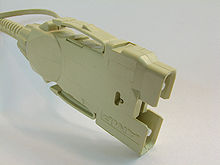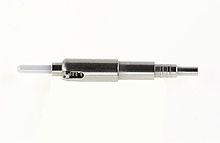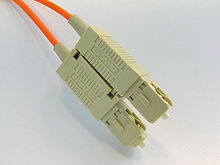- Optical fiber connector
-
An optical fiber connector terminates the end of an optical fiber, and enables quicker connection and disconnection than splicing. The connectors mechanically couple and align the cores of fibers so that light can pass. Better connectors lose very little light due to reflection or misalignment of the fibers.
Contents
Application
Optical fiber connectors are used to join optical fibers where a connect/disconnect capability is required. The basic connector unit is a connector assembly. A connector assembly consists of an adapter and two connector plugs. Due to the polishing and tuning procedures that may be incorporated into optical connector manufacturing, connectors are generally assembled onto optical fiber in a supplier’s manufacturing facility. However, the assembly and polishing operations involved can be performed in the field, for example, to make cross-connect jumpers to size.
Optical fiber connectors are used in telephone company central offices, at installations on customer premises, and in outside plant applications. Connectors are used to connect equipment and cables, or to cross-connect cables within a system.
Most optical fiber connectors are spring-loaded. The end faces of the fibers in the two connectors are pressed together, resulting in a direct glass to glass or plastic to plastic contact. This avoids a trapped layer of air between two fibers, which would increase connector insertion loss and reflection loss.
Every fiber connection has two values :
- Attenuation or insertion loss
- Reflection or return loss.
Measurements of these parameters are now defined in IEC standard 61753-1. The standard gives five grades for insertion loss from A (best) to D (worst), and M for multimode. The other parameter is return loss, with grades from 1 (best) to 5 (worst).
A variety of optical fiber connectors are available, but SC and LC connectors are the most common types of connectors on the market. Typical connectors are rated for 500–1,000 mating cycles.[1] The main differences among types of connectors are dimensions and methods of mechanical coupling. Generally, organizations will standardize on one kind of connector, depending on what equipment they commonly use. Different connectors are required for for multimode, and for single-mode fibers.
In datacom and telecom applications nowadays small connectors (e.g., LC) and multi-fiber connectors (e.g., MTP) are replacing the traditional connectors (e.g., SC), mainly to provide a higher number of fibers per unit of rack space.
Features of a good connector design:
- Low Insertion Loss
- Low Return Loss
- Ease of installation
- Low cost
- Reliability
- Low environmental sensitivity
- Ease of use
Outside plant applications may involve locating connectors underground in subsurface enclosures that may be subject to flooding, on outdoor walls, or on utility poles. The closures that enclose them may be hermetic, or may be free-breathing. Hermetic closures will subject the connectors within to temperature swings but not to humidity variations unless they are breached. Free-breathing closures will subject them to temperature and humidity swings, and possibly to condensation and biological action from airborne bacteria, insects, etc. Connectors in the underground plant may be subjected to groundwater immersion if the closures containing them are breached or improperly assembled.
Depending on user requirements, housings for outside plant applications may be tested by the manufacturer under various environmental simulations, which could include physical shock and vibration, water spray, water immersion, dust, etc. to ensure the integrity of optical fiber connections and housing seals.
Types
Fiber connector types Short name Long form Coupling type Ferrule diameter Standard Typical applications Avio (Avim) Screw Aerospace and avionics ADT-UNI Screw 2.5 mm Measurement equipment Biconic Screw 2.5 mm Obsolete D4 Screw 2.0 mm Telecom in the 1970s and 1980s, obsolete Deutsch 1000 Screw Telecom, obsolete DIN (LSA) Screw IEC 61754-3 Telecom in Germany in 1990s; measurement equipment; obsolete DMI Clip 2.5 mm Printed circuit boards E-2000 (AKA LSH) Snap, with light and dust-cap 2.5 mm IEC 61754-15 Telecom, DWDM systems; EC push-pull type IEC 1754-8 Telecom & CATV networks ESCON Enterprise Systems Connection Snap (duplex) 2.5 mm IBM mainframe computers and peripherals F07 2.5 mm Japanese Industrial Standard (JIS) LAN, audio systems; for 200 μm fibers, simple field termination possible, mates with ST connectors F-3000 Snap, with light and dust-cap 1.25 mm IEC 61754-20 Fiber To The Home (LC Compatible) FC Ferrule Connector or Fiber Channel [2] Screw 2.5 mm IEC 61754-13 Datacom, telecom, measurement equipment, single-mode lasers; becoming less common Fibergate Snap, with dust-cap 1.25 mm Backplane connector FSMA Screw 3.175 mm IEC 60874-2 Datacom, telecom, test and measurement LC Lucent Connector [2], Little Connector, or
Local Connector[citation needed]Snap 1.25 mm IEC 61754-20 High-density connections, SFP transceivers, XFP transceivers ELIO Bayonet 2.5 mm ABS1379 PC or UPC LuxCis 1.25 mm ARINC 801 PC or APC configurations (note 3) LX-5 Snap, with light- and dust-cap IEC 61754-23 High-density connections; rarely used MIC Media Interface Connector Snap 2.5 mm Fiber distributed data interface (FDDI) MPO / MTP Multiple-Fibre Push-On/Pull-off [2] Snap (multiplex push-pull coupling) 2.5×6.4 mm [3] IEC-61754-7; EIA/TIA-604-5 (FOCIS 5) SM or MM multi-fiber ribbon. Same ferrule as MT, but more easily reconnectable.[3] Used for indoor cabling and device interconnections. MTP is a brand name for an improved connector, which intermates with MPO.[4] MT Mechanical Transfer Snap (multiplex) 2.5×6.4 mm Pre-terminated cable assemblies; outdoor applications[3] MT-RJ Mechanical Transfer Registered Jack or Media Termination - recommended jack [2] Snap (duplex) 2.45×4.4 mm IEC 61754-18 Duplex multimode connections MU Miniature unit [2] Snap 1.25 mm IEC 61754-6 Common in Japan NEC D4 Screw 2.0 mm Common in Japan telecom in 1980s Opti-Jack Snap (duplex) OPTIMATE Screw Plastic fiber, obsolete SC Subscriber Connector [2] or
square connector [2] or
Standard ConnectorSnap (push-pull coupling) 2.5 mm IEC 61754-4 Datacom and telcom; GBIC; extremely common SMA 905 Sub Miniature A Screw Typ. 3.14 mm Industrial lasers, military; telecom multimode SMA 906 Sub Miniature A Screw Stepped; typ. 0.118 in (3.0 mm), then 0.089 in (2.3 mm)[citation needed] Industrial lasers, military; telecom multimode SMC Sub Miniature C Snap 2.5 mm ST / BFOC Straight Tip[2]/Bayonet Fiber Optic Connector Bayonet 2.5 mm IEC 61754-2 Multimode, rarely single-mode; APC not possible (note 3) TOSLINK Toshiba Link Snap Digital audio VF-45 Snap Datacom 1053 HDTV Broadcast connector interface Push-pull coupling Industry-standard 1.25 mm diameter ceramic ferrule Audio & Data (broadcasting) V-PIN V-System Snap (Duplex) Push-pull coupling Industrial and electric utility networking; multimode 200 μm, 400 μm, 1 mm, 2.2 mm fibers Notes
- Modern connectors typically use a "physical contact" polish on the fiber and ferrule end. This is a slightly curved surface, so that when fibers are mated only the fiber cores touch, not the surrounding ferrules. Some manufacturers have several grades of polish quality, for example a regular FC connector may be designated "FC/PC" (for physical contact), while "FC/SPC" and "FC/UPC" may denote "super" and "ultra" polish qualities, respectively. Higher grades of polish give less insertion loss and lower back reflection.
- Many connectors are available with the fiber end face polished at an angle to prevent light that reflects from the interface from traveling back up the fiber. Because of the angle, the reflected light does not stay in the fiber core but instead leaks out into the cladding. Angle-polished connectors should only be mated to other angle-polished connectors. Mating to a non-angle polished connector causes very high insertion loss. Generally angle-polished connectors have higher insertion loss than good quality straight physical contact ones. "Ultra" quality connectors may achieve comparable back reflection to an angled connector when connected, but an angled connection maintains low back reflection even when the output end of the fiber is disconnected.
- Angle-polished connections are distinguished visibly by the use of a green strain relief boot, or a green connector body. The parts are typically identified by adding "/APC" (angled physical contact) to the name. For example, an angled FC connector may be designated FC/APC, or merely FCA. Non-angled versions may be denoted FC/PC or with specialized designations such as FC/UPC or FCU to denote an "ultra" quality polish on the fiber end face.
- SMA 906 features a "step" in the ferrule, while SMA 905 uses a straight ferrule. SMA 905 is also available as a keyed connector, used e.g., for special spectrometer applications.
Mnemonics
- LC connectors are sometimes called "Little Connectors".[citation needed]
- MT-RJ connectors look like a miniature 8P8C connector — commonly (but erroneously) referred to as RJ-45.
- ST connectors refer to having a "straight tip", as the sides of the ceramic (which has a lower temperature coefficient of expansion than metal) tip are parallel—as opposed to the predecessor bi-conic connector which aligned as two nesting ice cream cones would. Other mnemonics include "Set and Twist", "Stab and Twist", and "Single Twist",[citation needed] referring to how it is inserted (the cable is pushed into the receiver, and the outer barrel is twisted to lock it into place). Also they are known as "Square Top" due to the flat end face.[citation needed]
- SC connectors have a mnemonic of "Square Connector", and some people believe that to be the correct name, rather than the more official "Subscriber Connector".[2] This refers to the fact the connectors themselves are square. Other terms often used for SC connectors are "Set and Click" or "Stab and Click".[citation needed]
Analysis
- FC connectors' floating ferrule provides good mechanical isolation. FC connectors need to be mated more carefully than the push-pull types due to the need to align the key, and due to the risk of scratching the fiber end face while inserting the ferrule into the jack. FC connectors have been replaced in many applications by SC and LC connectors.[5]
- There are two incompatible standards for key widths on FC/APC and polarization-maintaining FC/PC connectors: 2 mm ("Reduced" or "type R") and 2.14 mm ("NTT" or "type N").[6] Connectors and receptacles with different key widths either cannot be mated, or will not preserve the angle alignment between the fibers, which is especially important for polarization-maintaining fiber. Some manufacturers mark reduced keys with a single scribe mark on the key, and mark NTT connectors with a double scribe mark.
- SC connectors offer excellent packing density, and their push-pull design reduces the chance of fiber end face contact damage during connection; frequently found on the previous generation of corporate networking gear, using GBICs.
- LC connectors have replaced SC connectors in corporate networking environments due to their smaller size; they are often found on small form-factor pluggable transceivers.
- ST connectors have a key which prevents rotation of the ceramic ferrule, and a bayonet lock similar to a BNC shell. The single index tab must be properly aligned with a slot on the mating receptacle before insertion; then the bayonet interlock can be engaged, by pushing and twisting, locking at the end of travel which maintains spring-loaded engagement force on the core optical junction.
- In general the insertion loss should not exceed 0.75 dB and the return loss should be higher than 20 dB. Typical insertion repeatability, the difference in insertion loss between one plugging and another, is 0.2 dB.
- On all connectors, cleaning the ceramic ferrule before each connection helps prevent scratches and extends the connector life substantially.
- Connectors on polarization-maintaining fiber are sometimes marked with a blue strain relief boot or connector body, although this is far from a universal standard. Sometimes a blue buffer tube is used on the fiber instead.[7]
- MT-RJ (Mechanical Transfer Registered Jack) uses a form factor and latch similar to the 8P8C (RJ45) connectors. Two separate fibers are included in one unified connector. It is easier to terminate and install than ST or SC connectors. The smaller size allows twice the port density on a face plate than ST or SC connectors do. The MT-RJ connector was designed by AMP, but was later standardized as FOCIS 12 (Fiber Optic Connector Intermateability Standards) in EIA/TIA-604-12. There are two variations: pinned and no-pin. The pinned variety, which has two small stainless steel guide pins on the face of the connector, is used in patch panels to mate with the no-pin connectors on MT-RJ patch cords.
- Hardened Fiber Optic Connectors (HFOCs) and Hardened Fiber Optic Adapters (HFOAs) are passive telecommunications components used in an Outside Plant (OSP) environment. They provide drop connections to customers from fiber distribution networks. These components may be provided in pedestal closures, aerial and buried closures and terminals, or equipment located at customer premises such as a Fiber Distribution Hub (FDH) or an Optical Network Terminal or Termination (ONT) unit.
These connectors, which are field-mateable, and hardened for use in the OSP, are needed to support Fiber to the Premises (FTTP) deployment and service offerings. HFOCs are designed to withstand climatic conditions existing throughout the U.S., including rain, flooding, snow, sleet, high winds, and ice and sand storms. Ambient temperatures ranging from –40°C (–40°F) to +70°C (158°F) can be encountered.
Telcordia [8] contains the industry’s most recent requirements for HFOCs and HFOAs.
Testing
Glass fiber optic connector performance is affected both by the connector and by the glass fiber. Concentricity tolerances affect the fiber, fiber core, and connector body. The core optical index of refraction is also subject to variations. Stress in the polished fiber can cause excess return loss. The fiber can slide along its length in the connector. The shape of the connector tip may be incorrectly profiled during polishing. The connector manufacturer has little control over these factors, so in-service performance may well be below the manufacturer's specification.
Testing fiber optic connector assemblies falls into two general categories: factory testing and field testing.
Factory testing is sometimes statistical, for example, a process check. A profiling system may be used to ensure that the overall polished shape is correct, and a good quality optical microscope to check for blemishes. Optical Loss / Return Loss performance is checked using specific reference conditions, against a "reference standard" single mode test lead, or using an "Encircled Flux Compliant" source for multi-mode testing. Testing and rejection ("yield") may represent a significant part of the overall manufacturing cost.
Field testing is usually simpler. A special hand-held optical microscope is used to check for dirt or blemishes, and an optical time-domain reflectometer may be used to identify significant point losses or return losses. A power meter and light source or loss test set may also be used to check end-to-end loss.
See also
- Optical fiber cable Color coding of connector boot and fiber cable jackets
- Optical attenuator Fiber optic attenuator
- Gap loss Attenuation sources and causes
References
- ^ Alwayn, Vivek (2004). "Fiber-Optic Technologies". http://www.ciscopress.com/articles/article.asp?p=170740&seqNum=8. Retrieved Aug. 15, 2011.
- ^ a b c d e f g h i Keiser, Gerd (August 2003). Optical Communications Essentials. McGraw-Hill Networking Professional. p. 132–. ISBN 0071412042.
- ^ a b c Shimoji, Naoko; Yamakawa, Jun; Shiino, Masato (1999). "Development of Mini-MPO Connector". Furukawa Review (18): 92. http://www.furukawa.co.jp/review/fr018/fr18_16.pdf.
- ^ "Frequently asked questions". US Conec. http://www.usconec.com/pages/faq/faqfrm.html. Retrieved 12 Feb 2009.
- ^ Hayes, Jim (2005). "Connector Identifier". The Fiber Optic Association — Tech Topics. http://www.thefoa.org/tech/connID.htm. Retrieved Feb. 6, 2009.
- ^ Sezerman, Omur; Best, Garland (December 1997). "Accurate alignment preserves polarization". Laser Focus World. http://www.laserfocusworld.com/display_article/31401/12/none/none/News/Accurate-alignment-preserves-polarization. Retrieved March 12, 2009.
- ^ "Polarization maintaining fiber patchcords and connectors" (pdf). OZ Optics. http://www.ozoptics.com/ALLNEW_PDF/DTS0071.pdf. Retrieved Feb. 6, 2009.
- ^ GR-3120, Issue 2, April 2010, Generic Requirements for Hardened Fiber Optic Connectors (HFOCs) and Hardened Fiber Optic Adapters (HOFAs),
- Fiber optic connectors
- More fiber optic connectors
- Fiber optic connector identifier (with pictures and more connectors)
External links
Categories:- Fiber-optic connectors
Wikimedia Foundation. 2010.








